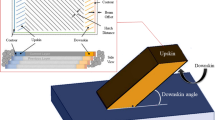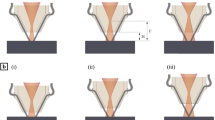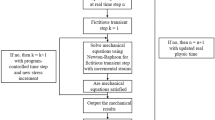Abstract
Additive manufacturing technology is an innovative and advantageous production technology in producing microchannels, heat exchangers designed in complex geometries. Process parameters developed to provide production standardization and quality standards on production results are known. The study investigates the sagging effect of downskin parameters on the downfacing surfaces of microchannels designed in different geometries. In this context, the productions and SEM examinations and the geometric corrections obtained with the developed parameter sets are shared with tables and graphic studies. The direct metal laser sintering (DMLS) method was used in the parameter and production studies within the study’s scope.






Similar content being viewed by others
Availability of data and material
The authors confirm that the data and material supporting the findings of this work are available within the article.
References
Aboulkhair NT, Everitt NM, Ashcroft I, Tuck C (2014) Reducing porosity in AlSi10Mg parts processed by selective laser melting. Addit Manuf 1:77–86. https://doi.org/10.1016/j.addma.2014.08.001
Ameen W, Al-Ahmari A, Mohammed MK, Mian SH (2018) Manufacturability of overhanging holes using electron beam melting. Metals 8(6):1–24. https://doi.org/10.3390/met8060397
Buchbinder D, Schleifenbaum H, Heidrich S, Meiners W, Bültmann J (2011) High power selective laser melting (HP DMLS) of aluminum parts. Phys Procedia 12(PART 1):271–278. https://doi.org/10.1016/j.phpro.2011.03.035
Calignano F, Manfredi D, Ambrosio EP, Iuliano L, Fino P (2013) Influence of process parameters on surface roughness of aluminum parts produced by DMLS. Int J Adv Manuf Technol 67(9–12):2743–2751. https://doi.org/10.1007/s00170-012-4688-9
Charles A, Elkaseer A, Thijs L, Hagenmeyer V, Scholz S (2019) Effect of process parameters on the generated surface roughness of down-facing surfaces in selective laser melting. Appl Sci (Switzerland) 9(6):1–13. https://doi.org/10.3390/app9061256
EOS. 2018. “Material data sheet.” 2018. https://fathommfg.com/wp-content/uploads/2020/11/EOS_Aluminium_AlSi10Mg_en.pdf.
Gao W, Zhang Y, Ramanujan D, Ramani K, Chen Y, Williams CB, Wang CCL, Shin YC, Zhang S, Zavattieri PD (2015) The status, challenges, and future of additive manufacturing in engineering. CAD Comput Aided Des 69:65–89. https://doi.org/10.1016/j.cad.2015.04.001
Gaynor AT, Guest JK (2016) Topology optimization considering overhang constraints: eliminating sacrificial support material in additive manufacturing through design. Struct Multidiscip Optim 54(5):1157–1172. https://doi.org/10.1007/s00158-016-1551-x
Khan HM, Dirikolu MH, Koç E (2018) Parameters optimization for horizontally built circular profiles: numerical and experimental investigation. Optik 174(August):521–529. https://doi.org/10.1016/j.ijleo.2018.08.095
Louvis E, Fox P, Sutcliffe CJ (2011) Selective laser melting of aluminium components. J Mater Process Technol 211(2):275–284. https://doi.org/10.1016/j.jmatprotec.2010.09.019
Mingear J, Zhang B, Hartl D, Elwany A (2019) Effect of process parameters and electropolishing on the surface roughness of interior channels in additively manufactured nickel-titanium shape memory alloy actuators. Addit Manuf 27(April):565–575. https://doi.org/10.1016/j.addma.2019.03.027
Mustafa SS, Lazoglu I (2020) A design framework for build process planning in DMLS. Progress in Addit Manuf 5(2):125–137. https://doi.org/10.1007/s40964-020-00110-0
Olakanmi EO (2013) Selective laser sintering/melting (SLS/DMLS) of pure Al, Al-Mg, and Al-Si powders: effect of processing conditions and powder properties. J Mater Process Technol 213(8):1387–1405. https://doi.org/10.1016/j.jmatprotec.2013.03.009
Paggi U, Sinico M, Thijs L, Dewulf W, and Van Hooreweder B. (2019) “Improving the dimensional accuracy of downfacing surfaces of additively manufactured parts.” Proceedings of the Special Interest Group Meeting on Advancing Precision in Additive Manufacturing, no. September: 35–38. https://lirias.kuleuven.be/2850508?limo=0.
Peng T, Lv J, Majeed A, Liang X (2021) An experimental investigation on energy-effective additive manufacturing of aluminum parts via process parameter selection. J Clean Prod 279:123609. https://doi.org/10.1016/j.jclepro.2020.123609
Pezzato L, Dabalà M, Gross S, Brunelli K (2020) Effect of microstructure and porosity of AlSi10Mg alloy produced by selective laser melting on the corrosion properties of plasma electrolytic oxidation coatings. Surf Coat Technol 404(October):126477. https://doi.org/10.1016/j.surfcoat.2020.126477
Ramesh KN, Sharma TK, Rao GAP (2020) Latest advancements in heat transfer enhancement in the micro-channel heat sinks: a review. Arch Comput Methods Eng Springer Netherlands. https://doi.org/10.1007/s11831-020-09495-1
Read N, Wang W, Essa K, Attallah MM (2015) Selective laser melting of AlSi10Mg alloy: process optimisation and mechanical properties development. Mater Des 65:417–424. https://doi.org/10.1016/j.matdes.2014.09.044
Sanaei N, Fatemi A (2020) Analysis of the effect of surface roughness on fatigue performance of powder bed fusion additive manufactured metals. Theor Appl Fract Mech 108(May):102638. https://doi.org/10.1016/j.tafmec.2020.102638
Snyder JC, Stimpson CK, Thole KA, Mongillo DJ (2015) Build direction effects on microchannel tolerance and surface roughness. J Mech Des, Transactions of the ASME 137(11):1–7. https://doi.org/10.1115/1.4031071
Stimpson CK, Snyder JC, Thole KA, Mongillo D (2017) Scaling roughness effects on pressure loss and heat transfer of additively manufactured channels. J Turbomach 139(2):1–10. https://doi.org/10.1115/1.4034555
Trevisan F, Calignano F, Lorusso M, Pakkanen J, Aversa A, Ambrosio EP, Lombardi M, Fino P, Manfredi D (2017) On the selective laser melting (DMLS) of the AlSi10Mg alloy: process, microstructure, and mechanical properties. Materials 10(1). https://doi.org/10.3390/ma10010076
Ullah R, Akmal JS, Laakso SVA, Niemi E (2020) Anisotropy of additively manufactured AlSi10Mg: threads and surface integrity. Int J Adv Manuf Technol 107(9–10):3645–3662. https://doi.org/10.1007/s00170-020-05243-8
Weingarten C, Buchbinder D, Pirch N, Meiners W, Wissenbach K, Poprawe R (2015) Formation and reduction of hydrogen porosity during selective laser melting of AlSi10Mg. J Mater Process Technol 221:112–120. https://doi.org/10.1016/j.jmatprotec.2015.02.013
Whip B, Sheridan L, Gockel J (2019) The effect of primary processing parameters on surface roughness in laser powder bed additive manufacturing. Int J Adv Manuf Technol 103(9–12):4411–4422. https://doi.org/10.1007/s00170-019-03716-z
Funding
This study was prepared within the scope of “ALUTEAM-Aluminum Test Training and Research Center,” carried out by Fatih Sultan Mehmet Vakif University.
Author information
Authors and Affiliations
Contributions
Cemal İrfan Çalışkan: Design process, experimental, discussion result section authorship, CAD modeling, and table studies; Dr. Gökhan Özer: literature authorship, SEM laboratory works, editorial, and translation; Mert Coşkun: DMLS process parameter study, DMLS productions, literature study, and table studies; and Dr. Ebubekir Koç: coordinator.
Corresponding author
Ethics declarations
Ethical approval
The article follows the guidelines of the Committee on Publication Ethics (COPE) and involves no studies on human or animal subjects.
Consent to participate
Not applicable. The article involves no studies on humans.
Consent to publish
Not applicable. The article involves no studies on humans.
Competing interests
The authors declare no competing interests.
Additional information
Publisher’s note
Springer Nature remains neutral with regard to jurisdictional claims in published maps and institutional affiliations.
Rights and permissions
About this article
Cite this article
Çalışkan, C.İ., Özer, G., Coşkun, M. et al. Investigation of direct metal laser sintering downskin parameters’ sagging effect on microchannels. Int J Adv Manuf Technol 114, 2567–2575 (2021). https://doi.org/10.1007/s00170-021-07057-8
Received:
Accepted:
Published:
Issue Date:
DOI: https://doi.org/10.1007/s00170-021-07057-8




